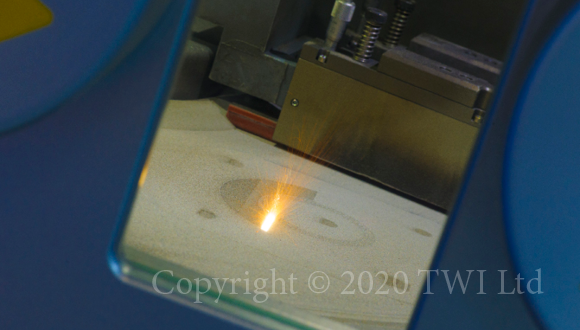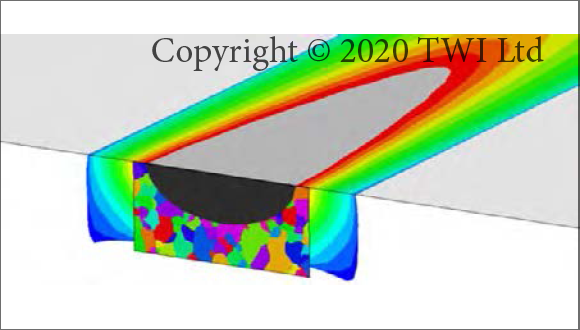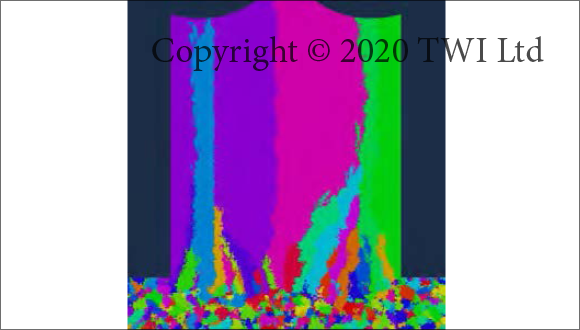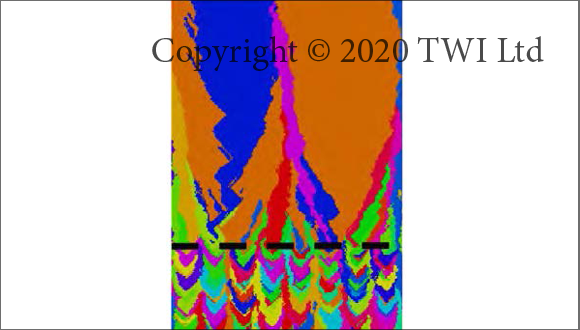Fri, 25 September, 2020
Madie Allen, TWI Project Leader and NSIRC and Brunel University London PhD student, presented her PhD research at NSIRC 2020 Live, speaking about numerical modelling, additive manufacturing technologies, microstructure and simulation.
......
......
Numerical modelling methods for the prediction of microstructure in metal additive manufacturing
Additive manufacturing (AM) is a novel manufacturing process that produces parts through the deposition of material layer by layer.
There are a number of different types of AM processes from powder bed fusion (PBF) methods to direct energy deposition (DED) techniques. PBF utilises a build chamber in which a layer of powder is spread and selectively melted according to a CAD file of the desired geometry.
On the other hand, DED processes deposit molten material at the position of the heat source. These include processes such as wire-arc additive manufacturing (WAAM) and laser metal deposition (LMD).
AM is set to become a $21.5 billion industry by 2025 [1] due to the large range of benefits it offers, including high material usage, the development of complex geometries and customisation opportunities.
 Figure 1: Laser Powder Bed Fusion. Image Courtesy of TWI Ltd
Figure 1: Laser Powder Bed Fusion. Image Courtesy of TWI Ltd
However, as with all new technologies there are some challenges and limitations preventing the widespread implementation of this manufacturing method within industry.
These challenges include manufacturing constraints, surface finish, as well as residual stress and distortion due to the rapid heating and cooling cycles. Moreover, there is a significant issue with the reliability and repeatability of additively manufactured parts.
This issue needs addressing to ensure the safety and performance of any AM part to be used within service.
In a recent additive manufacturing roadmap by the Lloyd's Register Foundation it was noted that the key to the development of safe products is through the understanding of the properties and performance of AM parts [2].
Material properties are determined by the microstructure of the part, which in turn is driven by the thermal history of the process. Thermal history can change greatly depending on the AM method implemented and the process parameters used within this technique. Therefore, it is important to be able to understand the links between process, microstructure and properties.
The approach
This project focuses on developing and implementing a numerical modelling method to help improve understanding on the links between process parameters and resultant microstructure.
Numerical modelling is an efficient way of investigating the effect of process parameters, particularly when there are a large amount of variables available, as there is for AM processes.
 Figure 2: Overlap between FE thermal model and CA microstructure model
Figure 2: Overlap between FE thermal model and CA microstructure model
The modelling approach undertaken within this work implements a Cellular Automata (CA) - Finite Element (FE) model.
Finite element models are used to simulate the thermal history of the AM process on a continuum scale. This involves modelling the heat profile as well as accounting for the scanning strategy, material deposition and heat losses involved within the process.
Thethermal model is then imported into the CA model to drive grain growth in the microstructure simulations.
Cellular automata models make use of a grid of cells, where each cell is assigned a number of state variables. These are updated throughout the model according to a prescribed set of rules.
Within this microstructure model, these state variables and rules are defined to represent the physical solidification mechanisms that take place within AM processes, and are based upon those used in the model presented by Rappaz and Gandin [3] for casting applications.
Work is now being seen within literature to apply these models to additive manufacturing processes.
Results of the research
A 2D version of the modelling approach has been validated using open source data provided by the NIST laboratories [4]. The set up involved a single laser scan across a bare IN625 substrate.
A strong level of agreement was achieved and the approach was deemed to be successful. Furthermore a statistical analysis has been undertaken to evaluate the probabilistic effects of the microstructure model. Following this work we are now applying the model to a DED process.
An extensively monitored experimental design has been undertaken, including thermocouple measurements, in order to validate FE thermal models before their implementation within the C models.
 Figure 3: Example of an application of the CA model to a Wire- Arc Additive Manufacturing process
Figure 3: Example of an application of the CA model to a Wire- Arc Additive Manufacturing process
A good level of visual agreement was achieved between experimental EBSD images and simulated microstructures. Qualitative measurements have also been undertaken.
Discussion
Within this work the modelling approach has been validated against a simple benchmark study. Following the success of this it has been applied to a direct energy deposition process and successfully simulated the key grain characteristics within the build part.
Future plans
The modelling approach implemented here offers a wide variety of applications for the future, from the prediction of grain size to help determine the strength of a material to the prediction of microstructural transitions for the development of functionally graded materials.
Future adoption of the methods will see a growth in understanding surrounding the processes involved in these complex manufacturing technologies and help accelerate the safe implementation of these parts in industry.
 Figure 4: Application of the model to a PBF microstructural transition
Figure 4: Application of the model to a PBF microstructural transition
Acknowledgements to Lloyd's Register Foundation, TWI and NSIRC
With thanks to the Lloyd's Register Foundation (LRF) for making this work possible. Lloyd’s Register Foundation helps to protect life and property by supporting engineering-related education, public engagement and the application of research.
The work was enabled through, and undertaken at, the National Structural Integrity Research Centre (NSIRC), a postgraduate engineering facility for industry-led research into structural integrity established and managed by TWI, a research and technology organisation, through a network of both national and international Universities.
References
- AM-motion, “Deliverable D5.4, Final AM Roadmap,”2018.
- Roadmap for additive manufacturing, Lloyd’sRegister Foundation Report series: FRSISP2015.1.v2/No. 1 (2016)
- Probabilistic Modelling of Microstructure Formation in Solidification Processes, M. Rappaz, Ch.-A. Gandin,Acta metall. Mater., Vol. 41, No. 2, pp 345-360,1993
- NIST AMB2018-02 Description - https://www.nist.gov/ambench/amb2018-02-description
......
Brief bio of Madie
Madie is in the final year of her PhD with NSIRC. Following a summer placement within the Numerical Modelling and Optimisation (NMO) team, she decided to undertake her PhD within the same section after completing her integrated masters in Maths (MMath) at Durham University. Madie has recently joined the team as a project leader whilst completing her studies. Her PhD focuses on the development and implementation of numerical models for metal additive manufacturing processes. Her research is sponsored by a Lloyd's Register Foundation scholarship
.....
Other articles that readers visited: